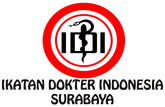The Effectiveness of Depigmentation, Interleukin-1B, and Transforming Growth Factor-B Antibodies in Activating and Increasing Collagenase in Keloid as Adjuvant Therapy After Scar Excision
Downloads
Background: Keloid is an abnormal scar in previously traumatic skin after going through the wound healing process. One hundred million cases have been found in developing countries with the main complaint of scar appearances. To overcome this problem, 24 literatures from various journals and textbooks are reviewed.
Reviews: Keloid formation is based on high melanin amount which inhibits the collagenase enzyme. Moreover, the high melanin amount would block interleukin (IL)-1B work resulting in collagen synthesis and collagenase reduction. Depigmentation effort with 4% hydroquinone is implemented to reduce the amount of melanin presented in the skin. With melanin reduction, IL-1B can work optimally by inhibiting fibroblast growth in keloid tissue without affecting on normal skin. It also induces Matrix Metalloproteinase (MMP)-1 which is an interstitial collagenase. IL-1B has an opposing effect compared to Transforming Growth Factor (TGF)-B, thus TGF-B antibody is needed to potentiate IL-1B therapeutic effect. TGF-B antibody can neutralize TGF-B ligand and avB6 integrin resulting in blocking of COL1A1 gene expression which is responsible for MMP-1 production and type-I collagen synthesis. These three components are combined in cream with liposome as a drug carrier. This combination is applicated for adjuvant therapy after scar excision. Liposomes are chosen because of their high biocompatibility, low toxicity, and low biodegradability. Liposomes also can release slowly in the extravascular area such as skin. This advantage may carry drug components effectively to the target location.
Summary: The combination of depigmentation, IL-1B, and TGF-B antibodies has a potency to be developed as a future adjuvant therapy of keloid.
Copyright (c) 2021 Indonesian Andrology and Biomedical Journal

This work is licensed under a Creative Commons Attribution-ShareAlike 4.0 International License.

















